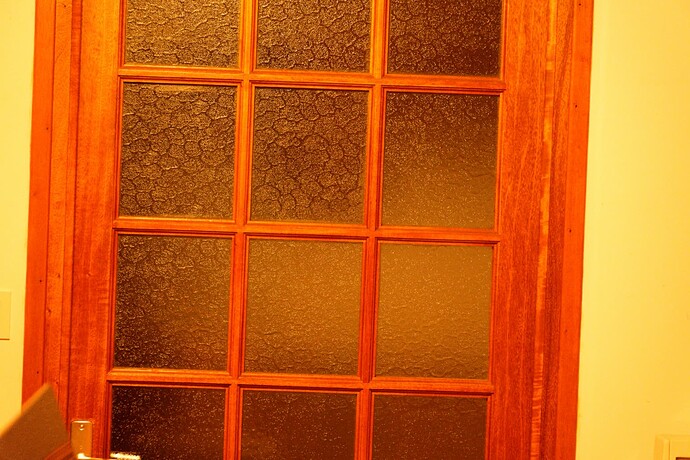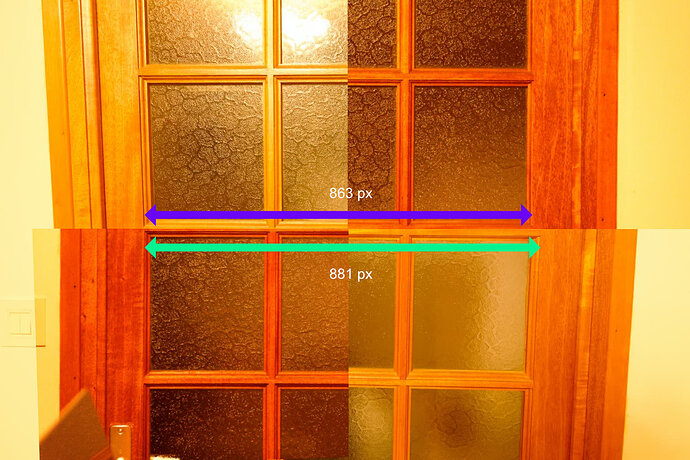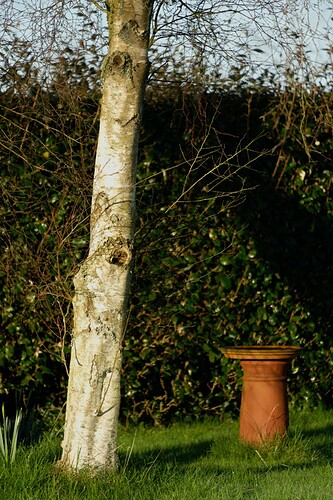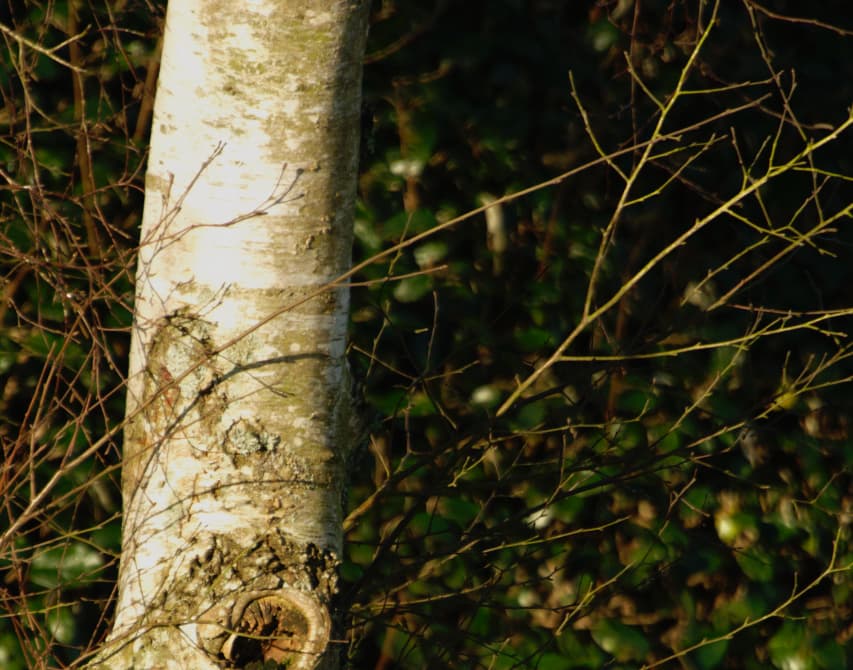@George Didn’t look at your diagrams. Used to look diagrams. Now feel with what I’ve learned.
Do you think my tests shoots (above) are consistent with your diagrams ?
Do you think they are valid ?
OK. I’ve just redone the test, ensuring, as close as possible to the same width and height for the panes of glass in the door (please excuse the handheld, high ISO, WB and noise).
28mm
170mm
TrueDoF-Pro set to 30µm blur circle diameter…
| Focal Length | Aperture | Focus Distance | DoF |
|---|---|---|---|
| 28mm | f/5.6 | 1.4m | 0.86m |
| 170mm | f/5.6 | 5.4m | 0.311m |
@Joanna
What do you think of the “not perfect” test I did ? To be perfect focal plane should be perfectly parallell to target, and I can’t do this.
How would be a face in place of the target.
Only Dof speaking, of course. Not perspective (wouldn’t like to see my noise with the second one ![]() ).
).
Sorry to say your test does not show any perspective to compare, and focus plane on both of them aren’t parallel. An pitch errors can lead to huge errors on focus distances.
So what do you think of shoots I’ve done ? (as imperfect as they can be).
Isn’t the dof on the ruler close enough on both ? This is an extreme range of lens don’t you think ? From 35 to 300 for portrait range seems huge, no ? (dof speaking).
The distances were taken from the centre of the centre rail, which is where I measured both the door width and the height of two panes of glass. to ensure they were as equal as possible without a micrometer.
Unfortunately, the scales are very difficult to determine and visually not possible to find what is inside the DoF and what is outside.
What I have done is to take two shots at different focal lengths, ensuring the subject size, when measured on the central axes, is the same in both. Then I entered those numbers into TrueDoF-Pro and the table you see contains the results.
There is significant difference between the two DoFs at the two distances of over 0.5m when calculated with a blur spot diameter of 30µm.
I couldn’t determine what blur spot diameter PhotoPills uses and it produces slightly different results…
| Focal Length | Aperture | Focus Distance | DoF |
|---|---|---|---|
| 28mm | f/5.6 | 1.4m | 0.91m |
| 170mm | f/5.6 | 5.4m | 0.33m |
… but still roughly the same difference of around 0.5m
Just download files. They are full size. Don’t know how to do better than 45 MPixel sensor …
Could by a sony ? Or a DxO one ?
Unit on ruler is ??? not sure : english unit. from up 6 to down 6 = 17 cm.
And Yes, I put some red lines to see imperfections, but as I said I have no way to do perfect alignment.
But I think it is better than doors.
Look at it. Soooo close …
Could you honestly say dof has changed if there was a face in place of the targets ???
This is field test, not theorical one.
Please, don’t ask me to build a giant target to test it in bigger space (wouldn’t blame you, you would be right, but maybe I would think I have to do it !).
For this scenario you need to set your camera to subject tracking as you will never managed to keep the focus point on a bird in flight! In fact for birds on flight I set my camera to full frame focus and it will find the bird for me and focus on it. Birds in flight is a difficult subject.
Earlier today, I had a one hour discussion with one of the tech support people at Fuji, discussing their X-Pro 3. I had no idea if I would end up buying one or not, but I was interested and curious. That led to my watching a comparison video of X-Pro 3 vs Leica M10, which mostly removed a lot of my enthusiasm about the X-Pro 3. I then read some of the comments. I quickly learned that the lenses for the X-Pro 3 are “focus by wire”, something I want nothing to do with. After a little searching, I’m now reading that lenses for mirrorless lenses are almost all “focus by wire”. Yikes. That killed any enthusiasm I still have for the X-Pro 3.
So, I went to DPReview, and quickly found this:
“The biggest problem with the Z cameras and manual focusing is not the finder lag – although that’s not great. Z cameras have adequate finder delay for focusing with lenses that have a helicoid. However, the focus-by-wire (FBW) implementation on every native Z lens I’ve tried – the 24-70/4, 35, 50, and 14-30 – is awful for precision work. It’s laggy and prone to overshoot…”
I could say more, but I’m tired of this stuff. I have completely lost interest in both the Fuji X-Pro 3, and anything with focus-by-wire.
Tomorrow I’ll get to try out a Nikon Z6 camera, not sure which one.
For a laugh, think of @Joanna trying to focus here LF camera using “focus by wire”… 
Back on topic, here are two images from this afternoon, each one learning from what I posted earlier, and trying to use sharpness to improve the image, by keeping what’s important to me sharp, and allowing other parts of the image to go out of focus.
First, another view of a small boat in the canal near me. This time I had all the time I wanted to set up the photo. Fuji X100f, and the autofocus caught the boat just as it came out from under the bridge I was standing on. I waited, and waited, and at what I hoped was the right time, took this photo, then two more as the boat got further away. Viewed at 100%, the image is what I consider perfectly sharp. So, a little work cropping, and making verticals vertical, and playing with a few tricks I learned from @Wolfgang and @platypus , small changes, but I liked the effect. Not very much editing. As I hoped, the background stuff is out of focus, but not by much. I can’t take credit for that, as the camera selected the settings, but I “encouraged it” to do what I wanted.
_DSF4627 | 2022-02-10.raf (48.2 MB)
_DSF4627 | 2022-02-10.raf.dop (13.6 KB)
Second, the tree from a few days ago. Taken with the Fuji X100f, I turned on the neutral density filter, allowing me to shoot at f/2, but the lens (the equivalent of 35mm on full frame) didn’t allow me to achieve what I was after. I’ll need to return, and use a real 50mm lens on one of my full frame cameras. Anyway, it’s closer to what I wanted to do, but the background is still too clear… One last thing - according to the histogram, the “brightness” of this image is correct. I’m tempted to make it even brighter, to stand out more, but from looking at the histogram from PL5, it is correct as-is. Any thoughts?
_DSF4640 | 2022-02-10.raf (48.2 MB)
_DSF4640 | 2022-02-10.raf.dop (14.2 KB)
I have mixed thoughts about the Fuji X100f. If I don’t want to do my part of the work, it’s a lovely little camera, and gets beautiful photos if I don’t mess up. But if I want to take over, as I might with my full frame cameras, I struggle. It has manual focusing, but it’s focus by wire, making it very imprecise. I would far prefer it to be full frame. It’s small, and light, and I can usually get it to do what I want, but that’s mostly me allowing it to do what it wants to do. My Leica forces me to do a lot more thinking, and work, much more. My D750 can be used either way, with me in charge, or the camera in charge. I hate to admit it, but I have the most confidence in the D750 of all of them, even with most of the automation turned off thanks to @Joanna - I used to wonder why I bought a camera with all these automated aids built in, if I de-activate them, but I’ve come to realize that now, it is “me” taking the photo, not the camera. It does what I want it to do, unlike today’s photos where the Fuji did all the hard work and I just composed.
Anyway, feel free to edit all you want, and see what you might create from these images.
The trouble with this exercise is to get the magnification not only approximately identical. Once again and not to blame you: it’s slightly off.
I took your pictures and did not enlarge or diminish them, but I turnt them so that the horizontal rail was aligned. As you can see, the picture with the 28mm is slightly wider than the 170 mm. Doesn’t seem much, but:
Strictly speaking, focal lengths are only valid for focussing at ∞. The closer you get, the longer the FL gets (which is the reason why my 105mm macro lens never shows f/2.8 when you get very close to 1:1, in fact the D850 shows f/4.8 at 1:1)
You’re much closer than ∞, so in both cases the real focal length is longer. And I don’t trust the values on your 28-300.
I also tried that game with a 35 and a 105 prime lens. I thought I had the right distances, but my pictures showed the same effect like yours just because the small screen is simply no precise enough. I first measured for the 105 mm lens 3598 mm to the target, then I tried again to get the result closer and measured 3700 mm.
@ f/5.6 the first distance has 41.08 cm DoF, the second distance 38.63 cm
With the 35 mm I measured 1314 mm (DoF: 48.07cm ). But if the lens doesn’t have exactly 35 mm FL, say 36 mm: DoF 45.25.
So, my DoF ranges are closer than yours, but no one of us really knows the true FL and I suspect with handheld photos the distance is not precise enough. I don’t know how you measured the distance, I used a laser. And after that I was curious as I know the D850 also shows the distance. Used the said 105/2.8 Micro Nikkor . EXIF says 2.99 m, laser says 2.572 m. Same setting with a 24 mm: 2.82 m or 5.01 m (don’t know how Nikon gets these numbers).
But all of this blurb of me is pretty much useless, as I already said no one will care much for DoF when there’s a compositional need to alter FL.
I can’t accept that. Focal length is a property of the lens, and is stamped on the lens, and the focal length is always measured at infinity. Everything else you write may be true, as the lens moves closer and further from the film or sensor, but the focal length value does not change.
Here is a good page that explains this:
https://photographylife.com/what-is-focal-length-in-photography
I’m not sure what this discussion and these images are trying to demonstrate.
I have no idea how any of it applies to me, in real life.
Sorry @mikemyers, you are both right and wrong. While old style lenses do have a single focal length, newer prime lenses can vary quite a bit. Example: A Canon EF 100mm macro lens has a focal length of 100 mm at infinity, but it changes to 75mm when focused for a 1:1 macro shot.
You’ll find a list of lenses at the end of this page. Some of the lenses keep their focal length, others don’t. It all depends on what a lens is optimised for.
According to the simple lens formula (1/focal length)=(1/image distance)+(1/subject distance). In photography the name effective focal length is introduced which is nothing else as the image distance.
When changing the focal length one is changing the angle of view. Even when one tries to get the subject identical framed the foreground and background are different enlarged. You can see that in @Joanna’s pictures of the bollard.
With the same framing of the subject and larger focal length:
- larger distance
- shorter the the angle of view
- larger enlargement of the background,
- less the perspective, which will become the next item

George
The diagram is a numerical approach of the subject. It gives an easy answer of the question how is dof divided, what is the influence of the aperture, focal length and distance.
George
Yeah, and after that (in the wide cosmos of hypertheoretical debates (did we have that word on the list, too?)) we need to look into the number of aperture blades, also the influence of filters to the focal length and the stacked filter glass in front of sensor, because, hey, the DoF calculators like the one from Photo Pills are telling me precisely on two digits behind the decimal when DoF starts and when it stopps, so we have to be sooo much more accurate. Urgently. As it always has to be in hyper theoretical debates. Thank you for letting loose this beast, @JoPoV I think my images will improve at least around 2,057 % with all that new knowledge. ![]()
![]()
If the definition of focal length is only valid for ∞ (never understood that bit and it’s consequences, I just take the long or the short one…), all lenses will keep their FL at ∞, because that spot is really farer away than the next supermarket, would be a long walk. The question is, how does the focal length change when focused to very close subjects? And how does this affect the DoF formula? And how much of this question do we need until it infects an average brain? This is a very nice, gentle and brave forum as somewhere else the ONE in possession of the only truth would already have used the text-block “go out shooting pictures”. ![]() but we won’t tell him.
but we won’t tell him. ![]()
Yeah right. Where do I put the battery? ![]()
Unfortunately, with an APS-C sensor, you’re going to get much more DoF than a full-frame. Then you used a 35mm equivalent focal length, which, as a wide angle even on a full frame, is going to increase the DoF even further.
Did you set the focus on the people in the boat? Or did you let the camera decide where the focal point is? As it is, it looks like the focus isn’t far off the hyperfocal distance, which is going to make almost everything “acceptably sharp”.
I just ran the focal length and aperture you used through TrueDoF-Pro and ended up with a hyperfocal distance of 5.5m (18ft), with everything acceptably sharp from 2.75m (9ft) to infinity, which would explain why you don’t have much blur at all in the distance.
Could you not have simply lowered the ISO by 2 stops instead of using the ND filter? I see that you used 640, but lowering it to 160 would have achieved the same thing.
This is a tricky one because, at f/2 there are parts of the tree that are not sharp but there is still too much DoF to blur the background enough.
One thing that you can do is use a longer focal length, from further away, to reduce the DoF further. I tried to do an example of a tree in our garden but I am limited by the maximum aperture on my 28-300mm lens to f/5.6.
28mm focal length…
300mm focal length…
But this also changes the perspective, as you can see by the relative size of the bird bath.
Taking a closer look, you can see that the hedge behind is a lot more blurred in the 300mm shot.
28mm focal length…
300mm focal length…
But you are never going to get a good blurred background with wide angle or even standard length lenses. Something else you can do is to try and choose a less distracting background?
And we have something as focusbreathing.
You forgot that one @JoJu 
@OXiDant are you trying to make life complicated for us poor bears of little brain? 

Danng, he noticed.  I was keeping that for the lovely fields of parfocal lenses.
I was keeping that for the lovely fields of parfocal lenses. 
When It turns towards “equivalence” I hope to be in holidays. This thread reminds me somewhat of my younger days, the “Rocky Horror Picture Thread”, especially the bit with “Madness… takes control” Forgot the Fn button for “time warp”.











